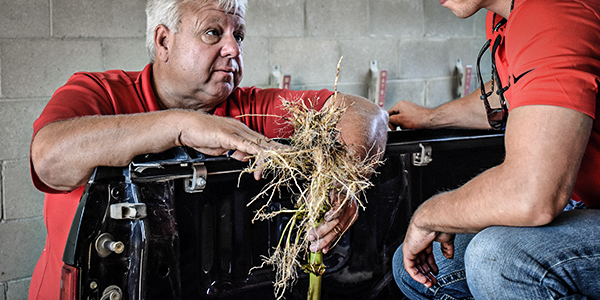AGRONOMICSUPPORT
YOU CAN TAKETO THE FIELD
Nitrogen Application and Uptake in Corn
As much of the corn crop reaches the V6 growth stage, a focus on the nitrogen needs of the crop begins. How much nitrogen will I need to hit my yield goal? How can I protect my nitrogen investment, so it is readily available for my corn crop? When should I apply my nitrogen? All these questions are being asked by farmers across the Corn Belt.
Nitrogen is one of the most important nutrients a corn plant needs. Nitrogen is an essential element needed for proteins in a corn plant. Protein is a contributing factor to green tissue formation as the plant continues to grow vegetation, as nitrogen is a major component of chlorophyll which is essential for photosynthesis. Nitrogen also plays a large role in the development of ear and kernels. Corn will take 50% of the nitrogen required during V8-R1. The rest will be taken up after R1. It is important that adequate nitrogen is applied for these crucial periods.
Nitrogen can exist in various forms. The most common is the ammonium form. This requires a conversion to the nitrate form in order to be best utilized by the corn plant. This occurs though the nitrogen cycle and breakdown of ammonium to nitrate by soil microbes. Ammonium is a positive ion which means it can bind with negatively charged soil and will be retained within the soil profile. When ammonium is converted to nitrate it then becomes a negatively charged ion and is easily leached down through the soil profile. This can cause available nitrogen to be unavailable to the root zone of the crop.
Split applications are preferred to maximize the availably of nitrogen for the corn crop. This helps to minimize the risk of excessive rainfall to leach away nitrogen prior to the crop being able to utilize it. This means that shortly before V8 is a great time to begin applying nitrogen to the corn crop. It is ideal to split this application up and apply some before V8 and the balance of the nitrogen at tassel. It is also recommended to look at stabilizing the nitrogen you apply. This can be done by treating the nitrogen with urease inhibitors, nitrification inhibitors, and slow released coated fertilizer. Depending on the type of nitrogen you are applying it is a great investment to stabilize the nitrogen to slow the release and availability to make sure the nitrogen is there when the crop needs it.
If you are confused on how much nitrogen to apply to your corn crop, Advantage Acre® allows a grower to look at the weather and a yield goal to calculate how much nitrogen it will take to achieve the yield desired. The Nitrogen Tool calculates the weather, rainfall, and how a specific variety responds to nitrogen on a field by field basis. It looks at when and how much nitrogen you have applied and will help you decide how much nitrogen to side dress. This can also be made into a variable rate prescription to maximize your nitrogen investment and apply it in exactly the right place.
If you have any questions regarding how much nitrogen to apply make sure and contact your local Technical Team Agronomist.
Download a copy of this technical bulletin here: Nitrogen Application and Uptake
Additional Information:






Technical Team Agronomist